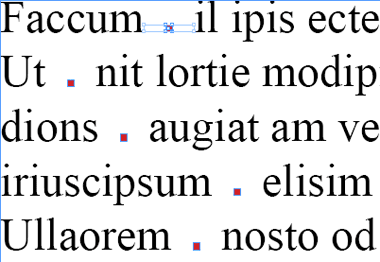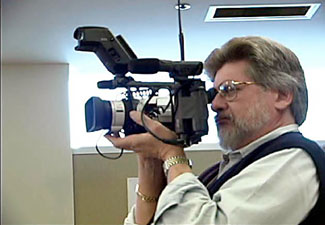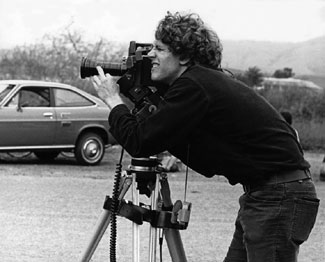Get Moving: Still Photographers Learn Video Storytelling

In early January my buddy Jim Sugar sent me an email asking if I planned to attend the Platypus Workshop on Digital Video. Jim is a veteran photojournalist with decades of experience with many prestigious publications.

Dirck Halstead shoots videotape at the Platypus Video Workshop in January, 2000.
Platypus is a program presented by photojournalist Dirck Halstead. He has assembled a team of instructors who train the next generation of video storytellers, the folks who will be filling the "content" pipes of television and new media in the future. Halstead’s approach is to train the world’s talented pool of still photographers on the techniques of videotape shooting and editing. It’s an approach that’s working.
Graduates of the Platypus workshops have had more than a half-dozen features aired on ABC’s "Nightline" in the last 12 months. Halstead’s idea that still photographers have "the eye" for video journalism is right on target. His graduates prove this daily as they venture into creating moving pictures with sound.
On Location
Jim Sugar cajoled me into joining him at the Platypus workshop in January. I sent in my money and I showed up for the class. And it changed my vision of the future. Over eight days we lost a lot of sleep and stuffed our brains with information on video journalism, editing, and story-telling techniques that will make us more effective communicators in the future.

Platypus Workshop participants listen to a lecture on video technique. In the foreground is Jim McNay, and instructor in the San Jose State University Journalism program. Left front row is Mark Hinajosa of the Chicago Tribune.
The class was held at Apple Computer’s Cupertino campus. Our classroom was stocked with Canon digital video cameras, Sony DV decks, and Macintosh G4s loaded with Apple’s Final Cut Pro software.
Each day we would listen to lectures, watch example videotapes, and then head out into the world to shoot videotape stories with the Canon cameras. Assignments varied from "Vox Pop" the first day to a two-minute story edited for presentation on the final day of the course.

Rick Smolan, publisher and photographer of Sausalito, California, looks through the viewfinder of a Canon XL1 digital video camera. Smolan was participating in the Platypus Video workshop in January, 2000.
"Vox Pop" is short for Vox Populi, or the voice of the people. For this assignment we went out into the nearby communities to interview people on current events, culture, television, or news events. We were to shoot no more than a few minutes of tape, and be prepared for a critique later that evening. My partner, Brandon Garcia, led me to some local haunts where we asked people in public places questions about football and the upcoming Super Bowl. We made some gaffes, and took a lot of ripe tomatoes in the critique. Our questions were too long, the answers too short.
We learned from our mistakes.
The second day Brandon and I shot a short documentary on the making of espresso coffee. Our camera and sound techniques improved as a result of the previous day’s critique. We did much better on the second critique.
Making Movies
Evenings were spent on additional lecture material, and learning the ropes of Final Cut Pro in the workshop classroom. We captured our scenes from the day’s shooting to the G4s, and we learned how to piece them together into a cohesive story.
Final Cut Pro is a software tool produced by Apple to provide broadcast quality editing on the G4 Macintosh computers. Teamed up with any digital video camera, the software provides a great platform for real, serious editing. Because we were studying in the Apple building, the staff arranged for us to be tutored by Apple staffers for some of our lectures. Midweek we had the opportunity to be taught some of the details of Final Cut Pro by its senior software architect, Randy Ubillos. What he showed us in a few hours was worth the price of admission by itself.
Our final assignment was to make a complete story with no more than 10 minutes of footage, and no more than two minutes of screen time. Brandon and I went out to shoot a story about a veteran orchestra musician who makes reeds for oboes and bassoons. We interviewed him to get what filmmakers call "A Roll," or primary footage, and we added "B Roll" shots of the process of making an oboe reed. We shot 9 minutes and 54 seconds of tape, and had more than enough to build a fairly complete story about our subject and his talents.
Our reviewers took us to task in the evening critique. The color balance of our interview was a little warm, one shot was out of focus, the continuity had some leaks. But in spite of the criticism, we fared well in making a good story in a short period of time. I felt we had accomplished a lot in just a week (view our finished project here).
I walked out into the daylight of reality after eight days of Platypus with new ideas of how to run my lectures and classes, on how to make better video components for my CD-ROM projects, and how to move into the next phase of my professional life as a better communicator.
Roll Tape!
Back in 1970 I worked as a television cameraman at our local NBC affiliate station, and worked for over a year as a weekend/nights newsman. My colleagues and I carried 16mm motion picture cameras and shot short (and often really bad) three-minute news stories about the goings-on in San Luis Obispo County, California.
We photographed politicians cutting ribbons, business people handing giant "checks" to charity organizers, public officials claiming or denying things on-camera, and we shot the (now politically incorrect) Weather Girl, which featured a lovely young woman doing something – cutting flowers, romping in the local surf, dancing in the ballet, etc. The Weather Girl footage was run as "Chroma Key" footage behind our news anchor as he read the weather report during the last two minutes of our nightly broadcast.
This experience shooting film was helpful to me in the Platypus video workshop, because many of the same challenges face today’s journalist that faced us in 1970. The great benefit today is that [digital?] digital video cameras don’t weight 21 pounds, and if you don’t like the "footage," you can rewind and shoot shoot over it. In my television days we were forced to shoot only one roll of motion picture film per story, get it "in the can" and then off to the processing machine on time. There was no rewinding in 1970.
As a result of this strict limitation on film usage, we learned to "edit in the camera," making sure to get the cut-away scenes to avoid jump-cuts, and get a few extra shots that could be edited in later, if needed, to complete the story. We worked hard to get silence before and after an interview so we could edit the sound effectively, and we learned how to do quick, just-before-deadline editing to prepare our stories for the nightly news. This involved cutting the film and editing the scenes with a splicer from reels of film on Moviola winders that we would crank back and forth to get to the editing points on our raw footage.
Editing on the Fly
It seems primitive now, as I sit in front of a Macintosh running Final Cut Pro. I can edit harmlessly — no scissors anywhere in this operation — and move sound and picture without difficulty to the exact spots where they belong.
Even something as simple as using a scene twice would have been impossible in 1970, because we had no method of duplicating footage. In today’s non-linear editing systems we can use any scene anywhere, anytime. We can run the sound under images that didn’t originally have that sound, and we can build on-the-fly dissolves and visual effects that were unthinkably difficult three decades ago.
I have now amassed the technology to shoot and edit Digital Video, and I am having a pretty smooth flight so far. This technology consumes disk space at a voracious clip, but disks are reasonably cheap, and the final product is of a quality that makes it all worthwhile.
My training at Platypus has rekindled an interest in motion and sound and storytelling, one that lay dormant for thirty years.

Brian Lawler with an Eclair NPR 16mm motion picture camera in 1971. The author was a news cameraman for NBC affiliate KSBY TV in San Luis Obispo, California.
Read more by Brian Lawler.
This article was last modified on June 30, 2023
This article was first published on May 23, 2000




